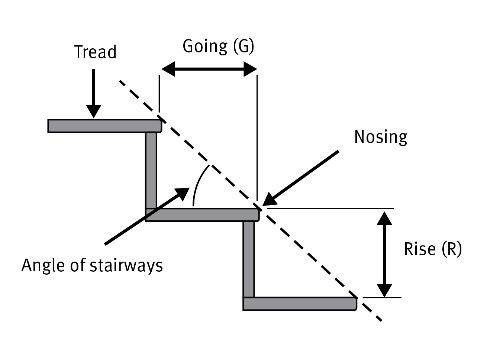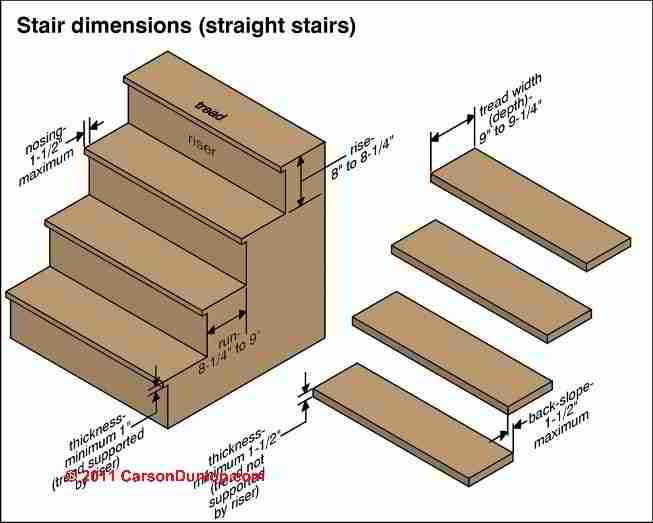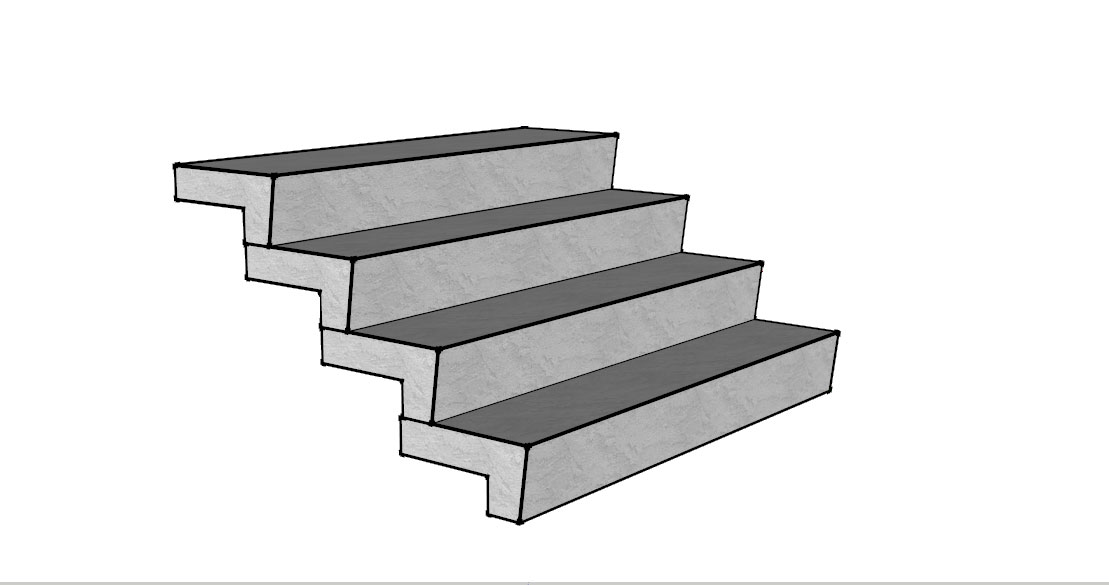minimum stair tread depth nz
Step Going Length. New drivers commonly forget to check their treadwear.

The Diagram Above Illustrates Some Of The Issues Pertinent To Designing Domestic Staircases To Avoid Homeowner Tumbl Stairs Design Reference Gorgeous Interiors
There isnt one unifying rule for every kind of material stair treads may be built out of.

. Minimum riser height is eight inches. Of course while the legal minimum is 15mm the more tread you have the better grip your tyres will have and the safer you will be so it. Avoid accidents and make site safety a priority.
Exactly Where How to Measure Stair Tread Depth. Building Code compliance document D1AS1 does not specify a width for common or main private stairways the most common stairway applicable within residential buildings but recommends no less than 850 mm. 300 13 3900 mm.
Stair treads need to be slip resistant and extend across the full width of the stairway. The tread depth is the distance from the front edge or nosing a tread projection that overhangs the riser below of one step to the front edge or nose of the next step measured horizontally. 41 Pitch risers and treads 27 42 Width 30 43 Landings 31 44 Curved and spiral stairways 33 45 Stair winders 33 46 Visibility of stair treads 33 50 Fixed Ladders 34 51 General 34 52 Step-type ladders 37 53 Rung-type ladders 38 54 Individual rung-type ladders 39 60 Handrails 39 Page 70 Doors and openings 43.
Staircase Tread Run Depth. When it comes to other materials the thickness may differ. The stair tread depth shall be measured horizontally between the vertical planes of the foremost projection of adjacent treads and at right angle to the treads leading edge.
Minimum headroom is generally 2 metres. Co-locate stairways with a step free route to provide users with a convenient step free alternative. The city defines minimum tread depths at nine inches with the nosing the exposed part of the tread measuring between 075 inches and 125 inches.
Planning a successful build. The faster you go the less effective your tyres will be if the tread depth isnt up to scratch. For safe healthy and durable buildings all building work in New Zealand must meet certain standards.
As for stair treads the depth should not be less than 10 inches however this will require nosing projections. Analysis of stairway related. Virtually all tyres have moulded tread-depth indicators.
What is code for rise and run of. Treads that project past the riser by at least 15 mm but not more than 25 mm to prevent toes being caught while walking up stairs. Both requirements will be checked at entry inspection when a vehicle first enters New Zealand and at periodic warrant of fitness or certificate of fitness inspections.
Multiply the tread depth by the number of treads to calculate the overall length of the stair. Treads that are all at the same width. A stair tread should be a minimum 95 deep for stairs used as equipment access under the OSHA standards for stairways.
When designing stairs factors to consider are the design parameters given in D1AS1. There is always one more riser than treads so for 14 risers there will be 13 treads. A stair tread should be a minimum of 11 deep for stairs used as a means of egress under the 2018 IBC building code.
BRANZ Guideline February 2012 stair widths. The minimum permitted tread depth is 280 mm but with ample space for the stairs 300 mm treads have been selected. 285 to 380 mm.
5 rows Riser height and tread depth should be of a uniform height within a tolerance of 5mm in one. Step Going Length Bottom. New Zealands Multi-award winning precast panels and treads 09 262 1065.
Variations between tread depths and riser heights must be no more than 0375 inches. The minimum permitted tread depth is 280 mm but with ample space for the stairs 300 mm treads have been selected. Tread width must be a minimum of 1200mm.
However a small number of tyres such as some retreaded or vintage tyres may not have moulded tread-depth indicators. Nose of the step should be slightly rounded. Multiply the tread depth by the number of treads to calculate the overall length of the stair.
Tread depth must provide adequate footing and be a minimum of 280mm. There are only minimum stair tread depth requirements. Tyres have treadwear indicators in the grooves that are 15mm tall.
Nosing that is beveled should not exceed ½ inch or the radius of curvature not more than 916 inch. 900 to 1580 mm. Even step heights risers the riser height plus one tread depth should be in the 580 mm to 620 mm range.
According to building codes stair tread for wood stairs has to be anywhere from 1 to 1 ½ in thickness. To avoid having to install nosing the code requires the depth of the tread to be no less than 11 inches. Riser vertical section between treads Height of between 01m and 018m and consistent for the entire flight.
The edge of treads should be visible against the background. 10 to 11 Inches Minimum. Slip resistant nosings can be added to meet these.
Once your tyre gets down to these blocks you know that its well past time to get a new tyre. A tread depth of at least 275 mm. This is because stair treads can be crafted from thick oak to think stainless steel.
Rises must be a maximum of 190mm. 285 to 300 mm. NZS 142120018STAIRS 811 states in what building an accessible route is required Any stair or floor covering that is not rounded to 5mm min to 10mm max as shown in the diagram below requires a stairnosing.
Stair width of 9001100 mm. Health and safety on site. How deep should a stair tread be.
No overhang at the edge of the tread. Solid risers are required. A step tread is the flat horizontal surface that you walk on.
Find out how to build within the rules. Adequate tread depth is essential for stairway safety. For further universal design guides checklists visit wwwaucklanddesignmanualconz.
The optimal tyre performance in the wet is achieved when your tyres have at least 3mm tread across 85 of the tyres width. Steps should be between 310-450mm deep and 150- 180mm high Step dimensions and profiles should be consistent across all steps All. Minimum Stair Tread Depth Chart.
Stair treads must have uniform rise within each flight and across consecutive flights a 5mm difference can make stairs unsafe. A tread depth of at least 275 mm. 10 units Minimum Tappered Riser.
Staircases must slope at an angle of 20 to 45 but between 30 and 38 is recommended. Stair tread depths shall be 11 inches 279 mm minimum. Depth no less than 031m and consistent for the entire flight measured from edge of step towards next riser.
For these the NZTA has retained the old requirement of at least 15mm tread depth across ¾ of the tread width and around the whole circumference of the tyre. 300 13 3900 mm Each tread will also have a 20 mm. The image below shows how much a tyre touches a wet road at different speeds.
Surfaces need to be slip-resistant under all conditions. The minimum legal depth is 15mm but the more tread you have the better the grip and the safer youll be.

Deck Stairs Stairs Stringer Deck Stair Stringer

External Stairs For Houses Branz Build

Residential Stair Codes Explained Building Code For Stairs Building Code Stair Treads Stairs

Stair Tread Depth Internachi Inspection Forum Stairs Treads And Risers Stair Treads Stair Dimensions

Framing A Staircase Fine Homebuilding Article Stairs Design Stairs Building Stairs

Stairs Handrail Height Building Code Stairs

Inspecting Stair Stringers Internachi
Osha Stair Requirements To Keep Your Workplace Safe And Productive

Safe Design And Use Of Stairs Worksafe Qld Gov Au

Minimum Winder Stair Design Step Or Tread Width Or Depth Winder Stairs Stairs Design Stairway Design

Timber Stair 29 Stylecraft Stairways Timber Stair Stairs Cedar Homes

Stair Stringer Calculator There Are Several Online Tried A Half Dozen This Was The Best For Underst Stair Stringer Calculator Stairs Stringer Stair Layout

Stair Dimension Stair Dimensions Stairs Treads And Risers Stair Layout

Stairway Tread Width Tread Nose Details For Stair Construction Inspection

Angles For Different Types Of Stairs Engineering Discoveries Types Of Stairs Stair Plan Building Stairs


